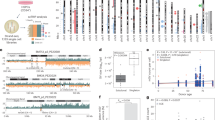Abstract
NUMEROUS studies have been made with the ultimate goal of establishing dose effect models that will enable quantitative assessments of the damage inflicted by various types of radiation exposures. In most, the animals were exposed to whole body gamma or X-irradiation delivered at high dose rates. The number of chromosome aberrations changes as a function of total radiation dose, radiation dose rate and time after exposure1–3, so it is not clear how these criteria apply in interpreting aberrations produced by internally deposited radionuclides which give low, continuous and non-uniform radiation dose rate exposures. Several workers have used in vivo or in vitro exposure to internal emitters and in vitro cell sampling to determine radiation damage4–7. These are relatively indirect, so we have tried to evaluate the influence of an internally deposited radionuclide on the frequency of chromosome aberrations produced and sampled in vivo. We selected 90Sr (in equilibrium with its daughter 90Y) because it exists in abundance in a number of nuclear processes, and localizes selectively in osseous tissues, resulting in beta irradiation of both bone and bone marrow. Aberrations in bone marrow cells are readily studied in vivo and may also be significant in the development of haematopoietic tissue neoplasms. We took two time periods, 2 and 14 days after injection, because differences in the aberration frequency which may be observed as a function of the total radiation dose and dose rate change with time.
This is a preview of subscription content, access via your institution
Access options
Subscribe to this journal
Receive 51 print issues and online access
$199.00 per year
only $3.90 per issue
Buy this article
- Purchase on Springer Link
- Instant access to full article PDF
Prices may be subject to local taxes which are calculated during checkout
Similar content being viewed by others
References
Sax, K., Genetics, 25, 41 (1940).
Brewen, J. G., Proc. US Nat. Acad. Sci., 50, 322 (1963).
Bender, M. A., and Gooch, P. C., Intern. J. Rad. Biol., 4, 175 (1961).
Bender, M. A., Gooch, P. C., and Prescott, D. M., Cytogenetics, 1, 65 (1962).
Dewey, W. C., Humphrey, R. M., and Jones, B. A., Radiat. Res., 24, 214 (1965).
Brewen, J. G., and Olivieri, G., Radiat. Res., 28, 779 (1966).
Moore, jun., W., and Colvin, M., Intern. J. Rad. Biol., 10, 391 (1966).
Parmley, W. W., Jensen, J. B., and Mays, C. W., Some Aspects of Internal Irradiation (Pergamon Press, 1962).
Darlington, C. D., and LaCour, L. F., The Handling of Chromosomes (George Allen and Unwin, 1960).
Brooks, A. L., and Lengemann, F. W., Radiat. Res., 32, 587 (1967).
Author information
Authors and Affiliations
Rights and permissions
About this article
Cite this article
BROOKS, A., McCLELLAN, R. Cytogenetic Effects of Strontium-90 on the Bone Marrow of the Chinese Hamster. Nature 219, 761–763 (1968). https://doi.org/10.1038/219761a0
Received:
Revised:
Issue Date:
DOI: https://doi.org/10.1038/219761a0
Comments
By submitting a comment you agree to abide by our Terms and Community Guidelines. If you find something abusive or that does not comply with our terms or guidelines please flag it as inappropriate.



